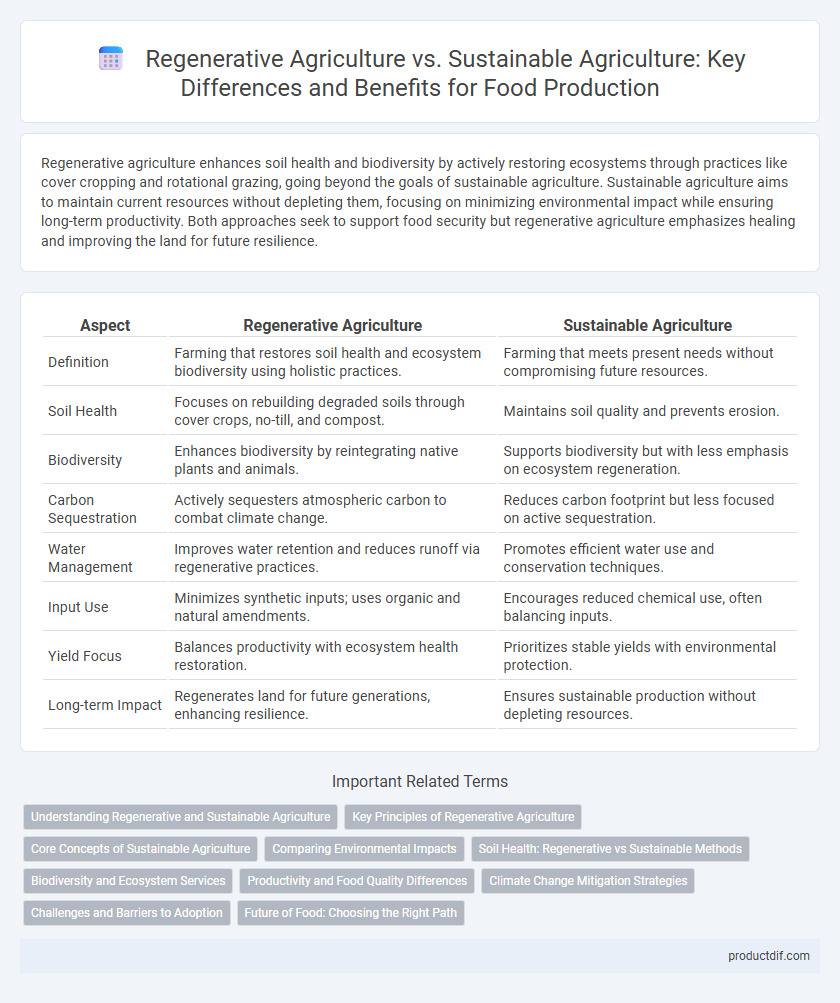Regenerative agriculture enhances soil health and biodiversity by actively restoring ecosystems through practices like cover cropping and rotational grazing, going beyond the goals of sustainable agriculture. Sustainable agriculture aims to maintain current resources without depleting them, focusing on minimizing environmental impact while ensuring long-term productivity. Both approaches seek to support food security but regenerative agriculture emphasizes healing and improving the land for future resilience.
Table of Comparison
| Aspect | Regenerative Agriculture | Sustainable Agriculture |
|---|---|---|
| Definition | Farming that restores soil health and ecosystem biodiversity using holistic practices. | Farming that meets present needs without compromising future resources. |
| Soil Health | Focuses on rebuilding degraded soils through cover crops, no-till, and compost. | Maintains soil quality and prevents erosion. |
| Biodiversity | Enhances biodiversity by reintegrating native plants and animals. | Supports biodiversity but with less emphasis on ecosystem regeneration. |
| Carbon Sequestration | Actively sequesters atmospheric carbon to combat climate change. | Reduces carbon footprint but less focused on active sequestration. |
| Water Management | Improves water retention and reduces runoff via regenerative practices. | Promotes efficient water use and conservation techniques. |
| Input Use | Minimizes synthetic inputs; uses organic and natural amendments. | Encourages reduced chemical use, often balancing inputs. |
| Yield Focus | Balances productivity with ecosystem health restoration. | Prioritizes stable yields with environmental protection. |
| Long-term Impact | Regenerates land for future generations, enhancing resilience. | Ensures sustainable production without depleting resources. |
Understanding Regenerative and Sustainable Agriculture
Regenerative agriculture emphasizes restoring soil health, increasing biodiversity, and improving ecosystem resilience through practices like cover cropping, reduced tillage, and crop rotation. Sustainable agriculture aims to meet current food needs without compromising future generations by promoting resource efficiency, minimizing pollution, and ensuring economic viability. Both approaches converge on environmental stewardship but differ in intensity and long-term ecological goals.
Key Principles of Regenerative Agriculture
Regenerative agriculture prioritizes soil health through practices like cover cropping, crop rotation, and reduced tillage to enhance biodiversity and carbon sequestration. It emphasizes restoring ecosystem functions by integrating livestock and promoting agroforestry, which improves water retention and soil fertility. These key principles distinguish regenerative agriculture from sustainable agriculture by focusing not only on maintaining resources but actively improving and revitalizing farm ecosystems.
Core Concepts of Sustainable Agriculture
Sustainable agriculture prioritizes long-term environmental health by maintaining soil fertility, reducing chemical inputs, and conserving water resources to ensure food security for future generations. It integrates crop rotation, organic farming practices, and biodiversity to create resilient agricultural systems that minimize ecological impact. Emphasizing economic viability and social responsibility, sustainable agriculture supports local communities and promotes equitable food distribution.
Comparing Environmental Impacts
Regenerative agriculture enhances soil health by sequestering carbon, improving biodiversity, and restoring natural ecosystems, whereas sustainable agriculture aims to minimize environmental harm through resource-efficient practices. While both methods reduce chemical inputs and support long-term productivity, regenerative agriculture emphasizes active ecosystem restoration, leading to greater carbon drawdown and improved water retention. In contrast, sustainable agriculture focuses more on maintaining current resource use and preventing degradation rather than reversing environmental damage.
Soil Health: Regenerative vs Sustainable Methods
Regenerative agriculture enhances soil health by actively rebuilding organic matter, improving water retention, and increasing biodiversity through practices like cover cropping, no-till farming, and rotational grazing. Sustainable agriculture aims to maintain soil fertility and minimize erosion using crop rotation, reduced chemical inputs, and conservation tillage, but often focuses more on sustaining current productivity levels rather than restoring soil ecosystems. Research shows regenerative methods significantly boost soil carbon sequestration and microbial activity, leading to long-term resilience against climate change impacts.
Biodiversity and Ecosystem Services
Regenerative agriculture enhances biodiversity by actively restoring soil health and promoting diverse plant and animal species, leading to improved ecosystem services such as pollination, water filtration, and carbon sequestration. Sustainable agriculture maintains existing biodiversity levels through practices that minimize environmental impact without necessarily rebuilding degraded ecosystems. Prioritizing regenerative methods offers greater potential for long-term ecosystem resilience and increased biodiversity compared to sustainable agriculture's emphasis on conservation and resource efficiency.
Productivity and Food Quality Differences
Regenerative agriculture enhances soil health through practices like cover cropping and no-till farming, leading to higher nutrient density and improved food quality compared to sustainable agriculture, which emphasizes resource efficiency and ecosystem balance. Productivity in regenerative systems can increase over time due to improved soil structure and biodiversity, whereas sustainable agriculture maintains consistent yields by minimizing environmental impact. The regenerative approach often results in crops with better flavor and nutritional profiles, reflecting deeper soil microbial activity and carbon sequestration.
Climate Change Mitigation Strategies
Regenerative agriculture enhances soil carbon sequestration by employing practices such as cover cropping, no-till farming, and agroforestry, which restore ecosystem health and increase biodiversity. Sustainable agriculture emphasizes resource efficiency and minimizing environmental impact through crop rotation, reduced chemical inputs, and water conservation, supporting resilience against climate change. Both strategies contribute to climate change mitigation but regenerative agriculture offers greater potential for long-term carbon drawdown and improved soil fertility.
Challenges and Barriers to Adoption
Regenerative agriculture faces challenges such as higher initial costs, limited access to knowledge and technology, and skepticism from conventional farmers, making widespread adoption difficult. Sustainable agriculture also encounters barriers including fragmented policies, lack of financial incentives, and market demand inconsistencies. Both practices require significant shifts in farming techniques, infrastructure, and education to overcome resistance and achieve scalability.
Future of Food: Choosing the Right Path
Regenerative agriculture emphasizes restoring soil health and biodiversity through practices like cover cropping and reduced tillage, promising enhanced carbon sequestration and long-term ecosystem resilience crucial for the future of food security. Sustainable agriculture focuses on balancing environmental health, economic profitability, and social equity, aiming to maintain productivity without depleting resources for future generations. Selecting the right path involves integrating regenerative techniques with sustainable principles to create a resilient food system capable of adapting to climate change and growing population demands.
Regenerative Agriculture vs Sustainable Agriculture Infographic

 productdif.com
productdif.com